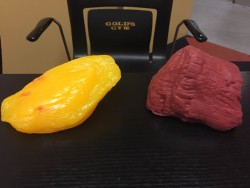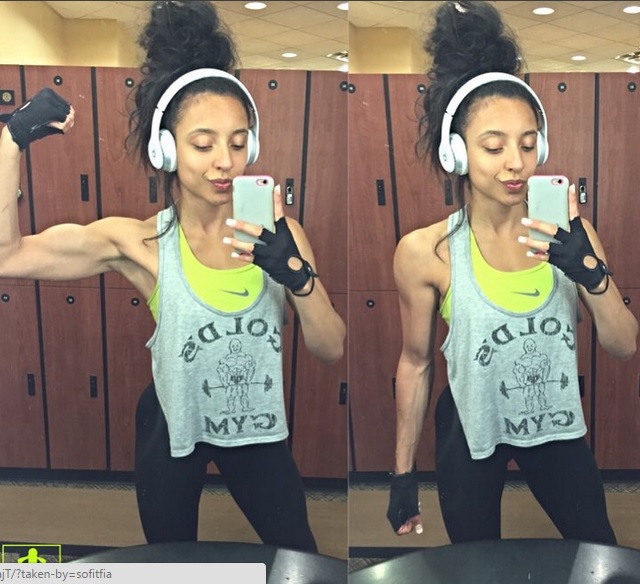When a woman client walks into my office at the gym, nine times out of ten one of these statements are made: “I want to make this flab more muscular,” “But I don’t want to bulk up,” “All my muscles have turned into fat,” or “I want to tone this fat up.” They are not to blame for these thought processes with misleading magazine and news headlines such as, “Turn your fat into muscle in 1 week!” It is my duty as a fitness professional to clear things up.
One of the most common misconceptions in the health and fitness industry is the belief that an individual can turn fat into muscle and muscle can become fat through inactivity and poor nutrition; however muscle and fat are not the same. They are two different entities, therefore fat can not become muscle, and vice versa: One cannot turn into the other. It is important we address the facts, as this is a popular topic in the press.

one pound of fat (left) and one pound of muscle (right)
WHAT is Fat, and what is Muscle?
Fat is an organ that has several functions in the body including storage of excess calories and releasing hormones, among other things. In the human body, there is ESSENTIAL & STORAGE fat. Essential fat is necessary for normal function in the body and small amounts are stored in the organs, central nervous system, bone marrow & muscle. On average, men have 4% and women have 12%. Storage fat includes two types of categories: Subcutaneous vs. Visceral fat. Subcutaneous fat lies right beneath the skin, is found mostly in the hips and gluteus, and has no real negative health implications. Visceral fat on the other hand is the type that is found deep around the vital organs, and in excess has some serious medical consequences. Individuals with higher body fat percentage, or large amounts of adipose fat around their waist/mid-section tend to be at a higher risk of disease: Insulin Resistance & Diabetes, Heart Disease, Cancer, Stroke and Dementia. Normal body fat for men and women differ depending on age and body type. What we fail to realize is fat is not just fat: It is an ACTIVE ORGAN that releases harmful chemicals, hence the danger of visceral fat surrounding the organs. However, the good news is this type of fat usually responds well to training & diet and decreases after the initiation of such lifestyle changes.
Muscle is tissue in the body that is responsible for movement, posture, and motion of the internal organs. Muscle is comprised of fibers, which is stretchy, elastic tissue. These fibers have nerves attached to them that allow contraction. There are three different types of muscle: cardiac, visceral or smooth, and skeletal muscle. For this article purposes, we will be referring to the latter type, which further breaks down into Type 1 (red, slow twitch) and Type 2 (fast twitch) muscles. Skeletal muscle allows movement of the peripheral body (including the limbs). These muscles surround the bones through tendons, attach to other muscles via ligaments, and give individuals their shape. On average, men body mass is comprised of 42% skeletal muscle, while in women its about 36%. These muscles as previously mentioned, are responsible for all movement of the body, and so are very important in terms of injury prevention and health. Having a higher amount of lean muscle mass through exercise, or “hypertrophy” of the muscle, is associated with many benefits.
Effects of Exercise and Nutrition
When an individual starts an appropriate exercise and nutrition program, they are most likely going to LOSE BODY FAT and GAIN LEAN MUSCLE. This is very beneficial from an aesthetic AND clinical/health standpoint (see above). Here are a few suggestions to build lean muscle and lose body fat:
1. Incorporate resistance training into your regimen: This type of training aids in building muscle. More lean muscle translates to better metabolic capacity, resulting in more calories being burned each day, even at rest. Basically, this means more weight or body fat loss over time. Aim to work all major muscle groups at least twice a week.
2. Use high intensity intervals and plyometrics: Instead of wasting so much time doing the typical long duration, steady state cardio all the time, perform more short bursts of higher intensity training. This type of exercise has been shown to burn a lot of calories and fat without compromising muscle, which is usually decreased with high amounts of low intensity cardio.
3. Eat 4-5 smaller meals a day: Eating only once or twice a day will actually decrease metabolism, which hinders fat loss. Even worse, skipping meals will lead your body into a “starvation mode,” which ends up with more fat storage.
4. Drink more water: Not only will this aid in body fat loss, but it will keep you full so you can avoid eating when not necessary. Aim to drink your weight in kg in ounces of water or more.
5. Don’t focus on the scale: One pound of muscle is more dense (takes up less space) than one pound of fat. This means it is important we DO NOT GET SO CONSUMED WITH THE SCALE! Do not make numbers an obsession. Body fat goes down with a proper workout, nutrition regimen, and a healthy lifestyle, regardless of weight. Chances are if you are exercising and eating healthy, you are increasing lean muscle, which in turn may end in little or no “weight loss” according to the scale. Focus on body fat percentage, pictures, how clothes are fitting, and HEALTH!
6. Stay consistent and be patient: Set a goal and take one day at a time. Building muscle and losing body fat does not happen overnight, so it is important you are realistic with your expectations. As long as you make consistent healthy choices over time, you can achieve anything!
Besides weight and fat loss, more lean muscle mass increases fitness, which is associated with a decreased risk of cardiovascular disease, cancer, diabetes and insulin resistance. In addition, exercise in general improves sleep, hypertension, and decreases risk of depression.
Do you understand the difference between muscle and fat now? Do you feel more confident on how to build muscle and decrease body fat and the benefits of such? If not, please ask questions in the comment section below!
Source: Medical news today.com
Also by Sofia: 10 Weight Loss Myths You Need to Get Over
Related: How to Build Your Home Gym for Under $100
Top 10 Vegan Snacks to fuel Your Workouts
Get more like this—Sign up for our daily inspirational newsletter for exclusive content!
Photo: Sofia Rodriguez





